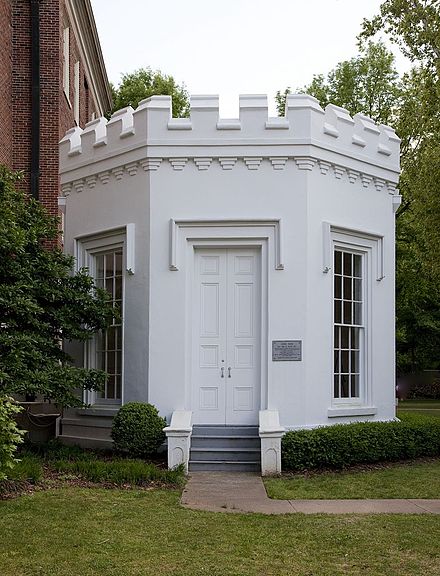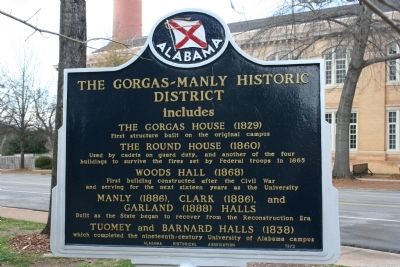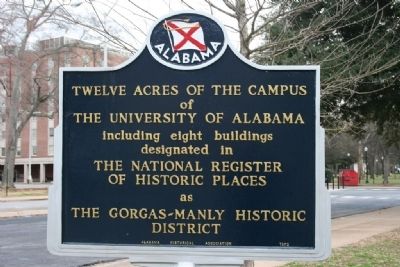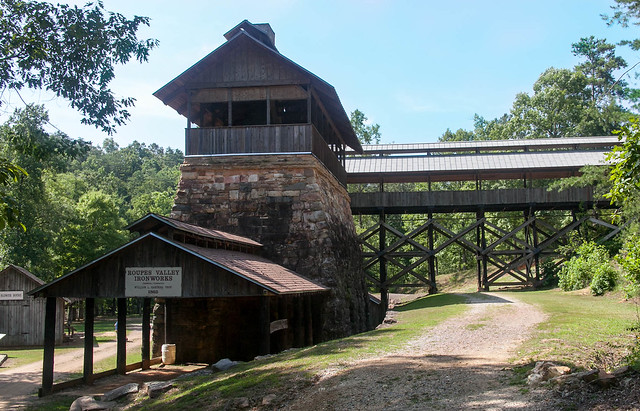There Are Eight Buildings in the Gorgas-Manly Historic District
The Gorgas-Manly Historic District is located on the University of Alabama Campus, and sets on over 12 acres of land.
It is made up of eight different buildings and gives visitors an idea of what the University looked like in the late 19th century.
It also illustrates what the campus looked like before the Union troops destroyed most of the University, during the final days of the Civil War.
 Old Structure at the Gorgas-Manly Historic District
Old Structure at the Gorgas-Manly Historic DistrictThe History of the Gorgas-Manly Historic District
 The Entrance Sign Marker
The Entrance Sign MarkerThis district of homes and buildings is not only considered to be the most historical in the town of Tuscaloosa, but also one of the most historical areas in the entire state.
Two of the buildings located there, the Gorgas House and the Little Round House, are two of the only eight structures that survived deadly onslaught.
Under the direction of Brigadier General John T. Croxton of the Union army, he led the raiding party that literally burned the University and most of its facilities to the ground, in April of 1865.
The First Four Building in the Gorgas-Manly Historic District
- The Gorgas House
- The Little Round House
- Woods Hall
- Clark Hall
The Gorgas House
Perhaps the most famous home in the Gorgas-Manly Historic District is the Gorgas houses, which was built in the year 1829.
This building served as a dining hall, a hotel, as well as the residence for the University’s Steward.
It was converted in the 1840’s to a faculty residence and is one of the original structures to survive the burning by the Union troops.
It was named after the Gorgas family that bought and lived in the house from 1879 until 1953.
Mr. Gorgas was the eighth President of the University.
It now serves as a museum and holds most of the Gorgas’s family furnishings, as well as large collection of memorabilia.
This includes several artifacts from the 19th century, and the building was added to the National Register of Historic Places in 1971.
It is an example of the original Greek revival style of home and was the first building on the campus.
The original designer of the Campus, William Nichols, also designed this home.
Completed in the year 1829, the main façade reflected the influence of the Federal style of homes.
The Little Round House
Next on the list of homes in the Gorgas-Manly Historic District is the Little Round House.
It was built in the year 1860, the same year the University was being converted to a military campus.
It was originally built to serve as a guard house for the University and was a small octagonal building.
It was also sparred by the Union troops burning rampage, and in 1871, once the University was reopened, it served as a doctor’s office.
However, it fell into despair, and was scheduled for demolition, but was saved by a group of trustees and turned into a records repository.
In the 1930’s it came to be known as Jason’s Shrine and was used by the Jason’s men’s honor society.
In the 1990’s, it was converted into a memorial for all of the honor societies at the University.
 One of the Structures
One of the StructuresWoods Hall
This was the first new building that was built on the University campus after the war ended.
Finished in 1868, it a four-story brick building with a Gothic revival arcade on the main floor, and has facades built in the Gothic revival style with a crenelated roof.
With its cast iron galleries on the central upper floors, it was commonly referred to as the “barracks.”
Used initially as a dormitory, it has also served as a dining room as well as classrooms.
After 1961, it was converted and used by the Department of Art and Art History.
Clark Hall
The next building of the Gorgas-Manly Historic District is Clark Hall, which was built in 1884.
It is a Gothic revival style structure and was built to serve as a library and had several large reading rooms.
It also had a very large public meeting room that allowed it to serve as a public meeting hall.
By the year 1910 it was near collapse because the roof was built too heavy and was only saved by the building of a steel frame near the center of the structure.
It now serves as the main office for the College of Arts and Science.
The Second Four Buildings in the Gorgas-Manly Historic District
 The Second Sign Marker
The Second Sign Marker- Manly Hall
- Garland Hall
- Tuomey Hall
- Barnard Hall
The next of the Gorgas-Manly Historic District is Monty Hall, which is a 3 plus story structure that was built in the year 1885.
It was first built to serve as a dormitory, and its current use is by the Department of Women’s Studies and the English Department.
It is named after the second President of the University, Basil Manly.
The Garland Hall is the next structure, and it is also built in the Gothic revival style, and was finished in 1887.
Built as another dormitory, it was the first structure in the University system to be named to the Alabama Museum of Natural History.
Today it is the home of the Sarah Moody Gallery of Art.
The Tuomey Hall is the next building in the Gorgas-Manly Historic District and is a 2 ½ story structure built in the year 1889.
It was built as a laboratory for the Department of Chemistry, and today is better known as the Blount Undergraduate Initiative Tuomey Academic House.
It also once served as the home of the Army ROTC for the University.
The final building is Richard Hall, which is also a 2 ½ story structure that was built in the year 1889.
It was also built as a laboratory as well as a gym, and its current use is by the College of Arts and Sciences
It is named after the scientist Fredrick Barnard, but was rededicated in the year 2000 as the Oliver-Barnard Hall in honor of John T. Oliver Jr.
References
https://enacademic.com/dic.nsf/enwiki/11673415

Alabama Gift Store
Numerous Items for You and Your Family to Enjoy
See it here at the Gift Store
Copyright 2019-2023 Alabamabackroads.com
All Rights Reserved

















